The New Motorola Moto X (2nd Gen) Review
by Joshua Ho on September 17, 2014 9:00 AM EST- Posted in
- Smartphones
- Motorola
- Android
- Mobile
Battery Life
Unlike most subjects that need significant explanation to justify the rigor of testing, battery life is something that everyone can appreciate. However, for those that are unfamiliar with our testing, we make it a goal to produce a repeatable, realistic test. In order to do this, our web browsing test runs a loop of webpages that ensures all power states with the screen on are properly represented in the test. In order to control for extraneous variables we standardize display brightness to 200 nits with strong signal.
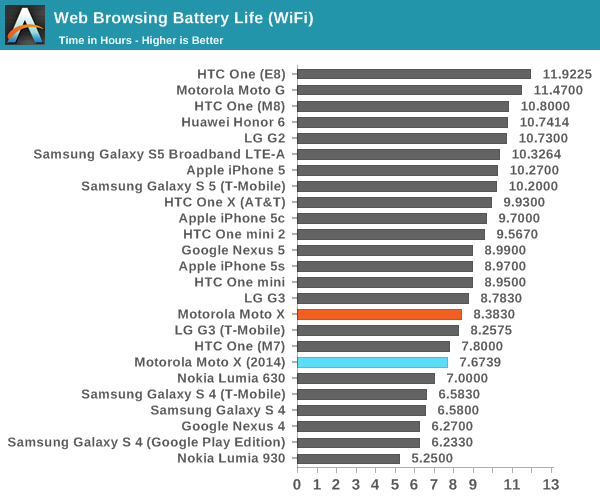
When running the web browsing test on WiFi, we see that the new Moto X manages to regress in battery life from the previous Moto X. This is a bit of an expected result as only the newer process of the SoC and new display technology can offset the decrease in battery size. In the LTE comparison there's a great deal more complexity as the previous Moto X had a less power efficient modem and RF front-end. The new Moto X has the same WiFi chipset as the previous Moto X, which is Qualcomm's WCN3680.
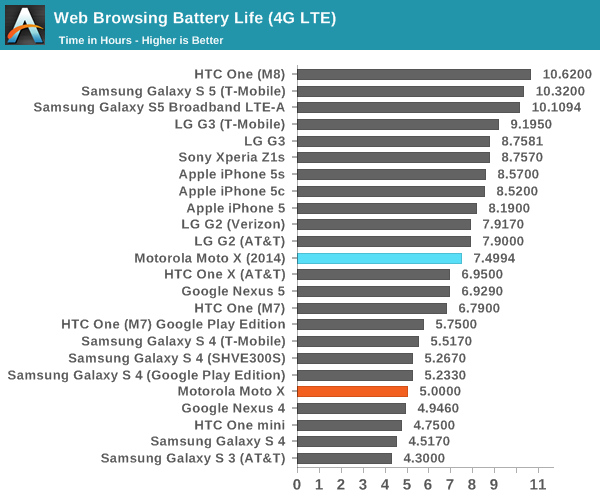
On LTE, the new Moto X is noticeably trailing behind the rest of the competition. Here we see that battery life is just behind the LG G2, but behind all recent Apple iPhones and just about every other Android high-end flagship phone launched in 2014. While the new Moto X has definitely improved over the previous Moto X, it seems that Motorola has used the newer AMOLED panel and lower power SoC to avoid using a significantly larger battery.
However, web browsing is not the only scenario worth testing. As the web browsing test is largely dominated by display power, it’s important that we test scenarios where all the other subsystems are more dominant in the power equation. For this, we turn to Basemark OS II and GFXBench 3.0, which focus more on CPU and GPU power consumption.
Unfortunately, I could not get our GFXBench rundown test to complete despite multiple attempts as it seems that the phone would either reboot or kill the application. Looking at the logs for the rundown test reveals that there’s no real change in FPS from run to run. After some extra investigation, it seems that this build (KXE21.187-43) doesn't do any throttling on GPU, so any workload that can keep the GPU at maximum heat output without dependence on CPU can cause the phone to reach unacceptable temperatures.
At any rate, the Basemark OS II run did complete so we can look at that.
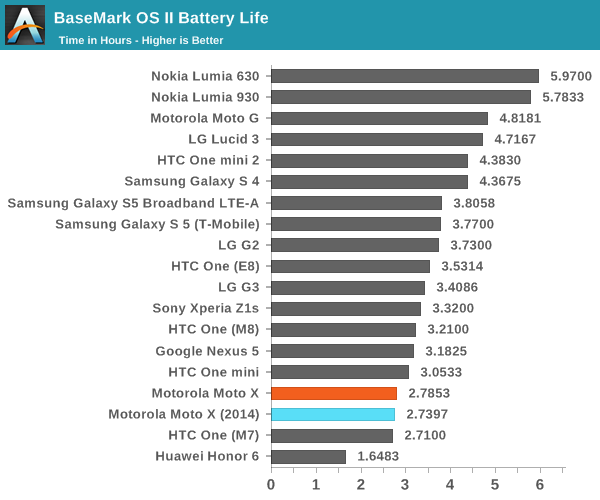
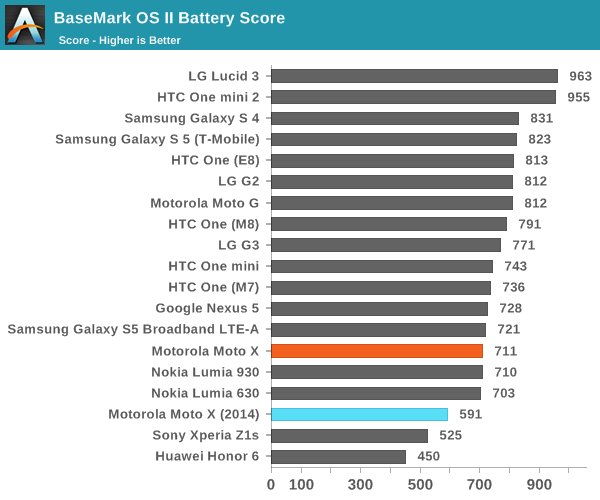
Unfortunately the Basemark OS II test reveals that battery life is poor compared to the competition. Normally, low battery life is compensated for by high performance but the battery score is only above the Sony Xperia Z1s and Huawei Honor 6, and the latter had no power budgeting mechanisms on the SoC to keep battery life at acceptable levels.
Overall, it’s hard to really say much in the way of praise for battery life. While it’s definitely surprising just how much battery life Motorola has achieved given the size of the battery and display, I suspect that Motorola found themselves in an uncomfortable situation as they tried to deliver a bigger display while keeping the phone easy to use with one hand. I suspect that all things considered, Motorola would have been better off if they went for a smaller display and the smaller height and width that would logically follow. It’s also not that the battery life is bad in an absolute sense, but it isn’t as good as its peers. Motorola is likely tracking closely to their estimated 24 hours of “mixed usage”. The use of Moto Display will also go a long way to reduce the time with the AP and display on.
Before I conclude this section, I just wanted to note that Android L alone won’t improve battery life on these tests. Android RunTime (ART) won’t help with battery life as these applications are native code. Job Scheduler is also irrelevant to our tests, as it will only improve battery life in situations where multiple applications are running in the background. We make every effort to ensure that no background tasks occur during these battery life tests and auto-sync is disabled as well in order to make sure that the only task running is the one under test. We have already run the data early in the summer on the Nexus 5 with Android L developer preview and our data does not show any significant difference in battery life. However, in real world usage where background applications and data syncing are active, one can expect greater battery life with Android L but only in the range of 10-15%.
Charge Time
While battery life from full charge to no charge is critical, in many situations the reverse is also important. For example, if one only has an hour before a flight, the rate at which the battery charges is just as important as the rate at which it discharges in use. In order to test this, the phone is connected to the included charger and the time from the battery begins charging to the time the charger stops drawing significant power is measured, as charging LEDs can often be an inaccurate method of determining charge time.
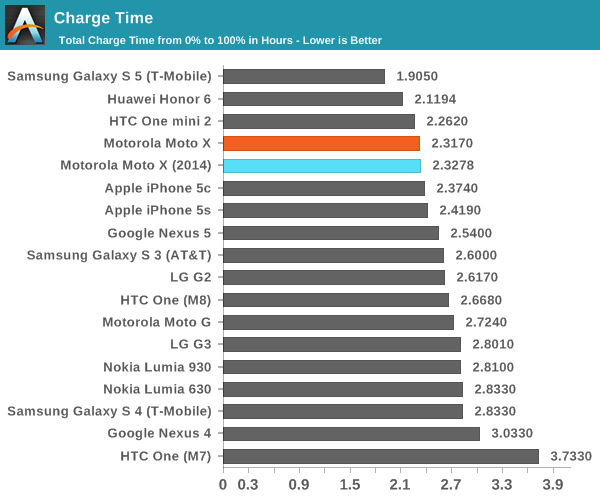
Motorola ends up on the high side here, which is somewhat expected due to the relatively small battery. I'm surprised that this is possible with a 5V, 1.15A charger though.


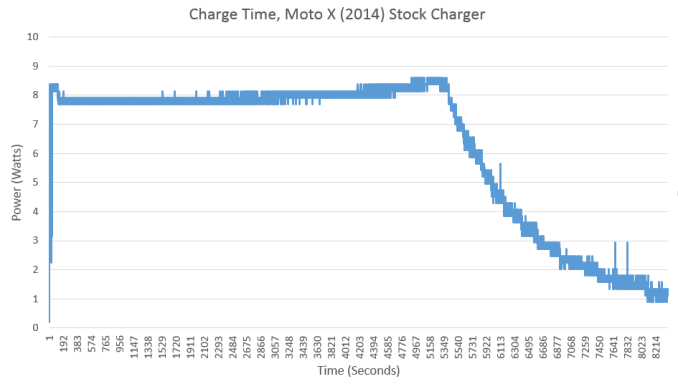








179 Comments
View All Comments
Jon Tseng - Wednesday, September 17, 2014 - link
Nice write-up on the semi content.One thing worth mentioning though might be the Moto Maker customisation options (which we're even getting in the UK!). Some of the premium leather/wood options definitely make the phone stand-out from competition (in a classy way, I might add).
semo - Thursday, September 18, 2014 - link
And once you get over oh la la nonsense you will wonder why you can't buy a more powerful aftermarket battery and why 1080p video recording is a chocolate teapot of a feature without an SD slot.It will be too late by then as you would have parted with your cash and voted for this trend to continue with your wallet. These nice things are only there to distract you from the planned obsolescence.
T1beriu - Wednesday, September 17, 2014 - link
I think the contrast graph is missing.JoshHo - Wednesday, September 17, 2014 - link
Infinite contrast would break the graph. :)s44 - Wednesday, September 17, 2014 - link
A small point... is it correct that only the *Sprint* version will have all the bands for full T-Mo operation when their version of 700mhz (Band 12) finally rolls out? I see Band 17 (due to be rolled into 12 at some point) listed on the GSM/Pure, and though perhaps a baseband update could enable 12, I know better than to expect that without an official announcement.Should full-price T-Mo buyers really be getting Sprint's X instead?
gg555 - Wednesday, September 24, 2014 - link
There's a lot of confusion out there about this. Also, given that Motorola tweeted a few days ago that there would be no Moto X for Sprint, it's not clear if model XT1092 actually exists or will ever be released.As far as I can see, only in this AnandTech review and a post at Android Central is there any mention of an XT1092 model. Also, on the Motorola site the XT1095 and XT1097 are not listed has supporting identical bands, as shown here at AnandTech. The XT1095 (Pure Edition) is show dropping a few of the LTE bands--which makes no sense to make a separate model that all it does is disable a couple bands.
Anyway, if the XT1092 does ever come to exist, as you note, it would be the best for T-Mobile because it supports LTE band 12 (700 Mhz)--which is just bizarre, given that the Pure Edition is being currently sold as the model for T-Mobile.
There's a thread in the Motorola forums where a company representative says they are aware of the confusion and looking into what is the deal with the bands on these phones, but no clarification has come yet.
https://forums.motorola.com/posts/d766a5d90a?page=...
djw39 - Wednesday, September 17, 2014 - link
Is there any thought that if the battery testing methodology ignores differences in devices due to the job scheduling setup and cell signal/wifi reception, that it is not giving the full picture? I'm sure the people at Motorola who worked on the antenna tuning are disappointed that you specifically exclude this from your tests.It seems like the LG G2 is a near-identical device with advantages over Moto in battery & camera. LG should just push their new UI skin out to that phone and keep selling it.
Impulses - Wednesday, September 17, 2014 - link
They made a G3 Mini or whatever that's basically a G2 rehash... Probably has a smaller battery tho, I forget.Problem with taking into account a job scheduler, varying signal conditions, etc is that it makes it near impossible to create a repeatable test with consistent results.
They could add ADDITIONAL tests like: battery life with borderline signal strength or battery life with a consistent sync job... But that would add to their already long battery of tests.
Plus where do you draw the parameters for tests like that (same signal strength for all phones or same scenario with varying low signal strength), and how do you keep it consistent (cell towers have varying loads, get upgraded, etc).
I suppose they could use that signal analyzer with the Faraday box Brian had for a while but I dunno if that could simulate a data traffic load.
leoblaze9 - Wednesday, September 17, 2014 - link
No love for the xperia z/z1/z2/z3 cameras at all??I was under the impression that they were among the best of the best cameras to be had in smartphones especially for android phones
adityarjun - Wednesday, September 17, 2014 - link
@Joshua Ho - A request: if possible please do the battery tests again once Android L is out for this phone.